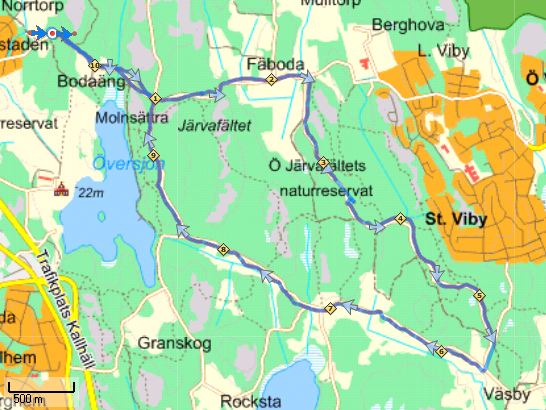This week, easter week was a very good week actually. Foodwise we kept in check and I had some really good runs including my first 10 km run this year. Weather has been perfect for outdoors activities so it has been a real pleasure to be outdoor this week. Dun has been nice and warm but in the nights the temperatures drops down and best runs are done in the afternoons really.
I have started using a new sports tracker on my Android phone called Endonundo and so far, for all similar softwares I have tested this one seems to be best of them all. I also love the BuddyRunner software but Endomondo does very much the same thing but has even better statistics.
Day by day
- Monday
- speed in the forest, 2.35 km in 6:36 tempo, pretty good for being me actually, I was very happy with that.
- Tuesday
- Altorp 6.7 km with Jenny, had a really good time as always and although I came home late it was a really good run that.
- Wednesday
- Resting, no training.
- Thursday
- My first 10 km this year. Eastern Järvafältet and that was good as well, but HARD. I was struggling at the end to keep it together and I had some walks in the middle of it as well but I did it even if it took me 99 minutes.

My first 10 km run this year - Friday
- Short runt at home, a very slow run to just flex everything up a bit from the 10 km the day before.
- Saturday
- A 5km run a new route I have not done before. Down to the Görväln castle and then back home again. Beautiful run but some hills that was really straining and by now I am starting to feel the miles in my legs this week. Decided this was last for this week!
- Sunday
- Resting.
This week
| Total distance | 26.8 | km | Total tim | 4:03:42 | HMS |
| Avg tempo | 9:06 | min/km | Avg. speed | 6.6 | km/h |
| Max. HR | 173 | bpm | Avg. HR | 148 | bpm |
| Training Effect | 4 | TE/EPOC | Energy spent | 3 032 | kcal |
| VO2(max) | 32 | ml/kg/min | Peak EPOC | 169 | ml/kg |
| Max. ventilation | 93 | l/min | Max breathing | 42 | bpm |
Last week
| Total distance | 16,8 | km | Total tim | 1:19:16 | HMS |
| Avg tempo | 8:29 | min/km | Avg. speed | 8.29 | km/h |
| Max. HR | 175 | bpm | Avg. HR | 153 | bpm |
| Training Effect | 5 | TE/EPOC | Energy spent | 1 162 | kcal |
| VO2(max) | 32 | ml/kg/min | Peak EPOC | 159 | ml/kg |
| Max. ventilation | 96 | l/min | Max breathing | 45 | bpm |
10 km more than last week is not horse manure. Probably too much of an increase in a single week but I feel good nevertheless. Time spent training also increased to more than the double, not bad at all but my average time dropped with 30 s/km. Not too surprising, longer runs and more km into the legs. Spending almost 3 times the amount of energy on running as last week, yay, almost two days worth of food.
Average heartrate has dropped a bit, longer and slower running and perhaps a bit better condition as well but the max hartrate is very similar and shows that I am still about 10 beats from maxing out. Good thing, don’t wanna do that alone… tried it once and i had such a bad tunnel vision I thought I was gonna faint.
Training effect is a 4 which is great compared to a 5 last week which was overtraining. Getting better at keeping slow on the long runs and not over-excerting myself to the point of breaking down rather than building up.
Ventilation and breathing is up a little though VO2max seems very similar. A higher peak EPOC and a lower Training Effect just means I have leveled on the training effect scale (to a level 6.0 from a 5.0 where I started).
Tomorrow is a resting day and then monday is a free day, I will see if my good friend Jenny can manage a nice run together then, looking forward to the next time.
Weight wise I have gone up 0.5 kg this week. Still keeping diet but I have also noticed my legs are getting stronger. I believe I am building more muscle. This is good, it means I will be able to run faster and longer and increase my metabolic rate even when I sleep. Good stuff that.




